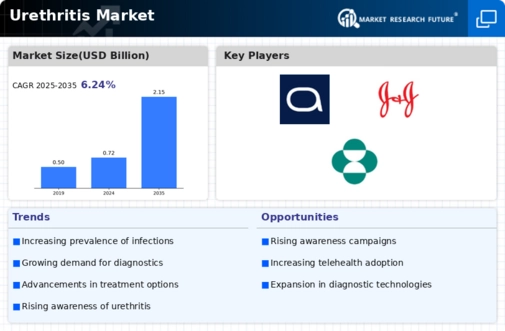Market Trends
Key Emerging Trends in the Urethritis Market
There are big changes happening in the Urethritis market, which is about the urethra's painful condition. These changes are caused by things like new ways of diagnosing the condition and different ways of treating it. These changes have an effect on how Urethritis is managed and cared for. There is more knowledge about sexual health problems, which helps people become more aware of Urethritis. As sexual health issues are talked about more openly, more people are going to the doctor for their complaints. This is causing more cases to be identified and more attention to be paid to prevention. The Urethritis market is seeing improvements in testing tools that make it easier and more accurate to find the things that cause the condition. Point-of-care diagnostics, PCR assays, and NAATs are being employed to detect urethritis rapidly and reliably. The market indicates that antibiotic-resistant kinds are increasing, which is concerning. This raises questions about the way Urethritis is usually treated and stresses the need for more research, new medicines, and different ways to treat the disease as the types of germs that cause it change. In the Urethritis market, symptomatic treatment is becoming more popular. This means treating based on clinical symptoms instead of waiting for lab results. This method lets help be given right away and lowers the risk of problems that come with waiting to get treatment. The market is responding to the growing worry of having two or more infections at the same time, especially when Urethritis and other sexually transmitted diseases (STIs) are present. This trend makes it clear how important it is to do full tests and use broad-spectrum treatments that cover a lot of possible diseases. Telemedicine services are changing the Urethritis market by making sexual health visits more available and private for people who want to talk about their problems. Telemedicine platforms make it easier to talk to doctors and nurses, which speeds up evaluation, medication, and therapy. Sexual health education programs are becoming more and more important to Urethritis market trends. Campaigns try to teach people about safe sexual practices, how important it is to get regular tests, and what might happen if you don't treat Urethritis, which helps with prevention and early intervention. There are research and development attempts going on in the urethritis market to come up with new treatments. Targeted antibacterial agents, immunomodulatory drugs, and strategies that target specific cause agents are some of the new ideas that show a dedication to making treatment work better. The Urethritis market is affected by global factors such as differences in how healthcare is provided, how people in different cultures feel about sexual health, and the frequency of different causes in different areas. Pharmaceutical businesses and healthcare workers that work in the Urethritis market need to be able to adapt to these worldwide differences. The use of AI is changing the Urethritis market by making it easier to analyze data, make diagnoses, and come up with specific treatment plans. AI technologies can help find patterns in the spread of infections, make treatment methods better, and help make control techniques work better. In the Urethritis market, community-based tests and marketing projects are becoming more popular. The goals of these programs are to make tests easier to get, make people more aware of Urethritis, and lower the social stigma surrounding it so that people are more likely to get medical help right away.






Leave a Comment